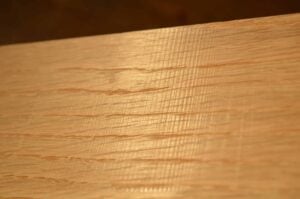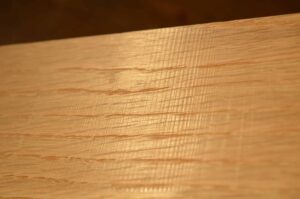Hey there, curious woodworker! Wondering why your hand plane starts to chatter when you’re trying to smooth out that piece of wood? Well, you’ve come to the right place. Let’s dive into the fascinating world of hand planes and uncover the mysteries behind this frustrating phenomenon.
Picture this: you’re using your trusty hand plane, gliding it smoothly over the surface of your workpiece, when suddenly, the plane starts to vibrate and make an annoying chattering sound. What gives? Why does this happen? Well, my friend, there are a few reasons why your hand plane might be misbehaving.
First off, it could be a matter of blade sharpness. A dull blade can cause the plane to skip and bounce instead of making nice, smooth cuts. But don’t worry, we’ve got some tips and tricks up our sleeve to help you fix that. So, strap in and get ready to uncover the secrets of banishing that pesky chatter from your hand plane. Let’s get started!
Is your hand plane chattering? Discover the reasons behind this common woodworking issue and how to fix it. Chatter occurs when the blade vibrates or skips on the wood surface, resulting in uneven cuts. The main culprits are blade sharpness, blade stability, improper setup, and technique. By addressing these factors, you can eliminate chatter and achieve smoother, more precise cuts with your hand plane. Get ready to master the art of woodworking!

Why Does My Hand Plane Chatter?
Hand planes are essential tools for woodworkers, allowing them to shape and smooth surfaces with precision. However, one common issue that woodworkers may encounter is the phenomenon known as “chatter.” Chatter refers to the undesirable vibration and skipping of the hand plane across the surface of the wood, resulting in uneven and rough finishes. In this article, we will delve into the reasons behind why hand planes chatter and explore various techniques to prevent or minimize this frustrating problem.
Common Causes of Hand Plane Chatter
Understanding the underlying causes of hand plane chatter is crucial in troubleshooting and addressing the issue effectively. Here are seven common factors that can contribute to chatter:
Dull or Incorrectly Set Blade
One of the main culprits of hand plane chatter is a dull blade or incorrect blade set-up. A dull blade will struggle to make clean cuts, leading to vibrations, while a poorly set blade can cause the plane to dig too deeply into the wood. Sharpening the blade regularly and ensuring it is properly aligned and at the correct depth are essential steps in avoiding chatter.
Insufficient Blade Support
Inadequate support for the blade can also lead to chatter. If the plane’s frog—the part that holds the blade—is loose, it may cause instability and vibrations. Regularly inspect and adjust the frog, ensuring it is firmly in place to provide optimal support for the blade.
Improper Plane Technique
Using the hand plane incorrectly can also contribute to chatter. Applying too much downward pressure, rocking the plane side to side, or inconsistent forward motion can all cause the plane to chatter. Developing proper planing technique, including maintaining a consistent angle and applying even pressure, is crucial for achieving smooth, chatter-free results.
Uneven Grain Orientation
The structure of the wood itself can be a factor in hand plane chatter. A piece of wood with irregular or interlocked grain patterns can cause the hand plane to encounter resistance and vibrate. Recognizing and understanding the grain orientation of the wood can help in adjusting the plane’s angle and direction to minimize chatter.
Inadequate Support or Clamping
When hand planing, providing adequate support for the wood is crucial. Insufficient support or improperly clamped workpieces can lead to vibrations and chatter. Using sturdy workbenches or work surfaces and ensuring the wood is securely held in place can help minimize this issue.
Poorly Set Mouth Opening
The mouth opening of a hand plane refers to the space between the blade and the front of the plane’s sole. If the mouth opening is too wide, it can allow wood fibers to tear out, leading to chatter. Adjusting the mouth opening to an appropriate size for the type of wood being planed can help reduce or eliminate this problem.
Incorrect Blade Angle
The angle at which the blade is set in the hand plane can also contribute to chatter. A lower blade angle (around 37-45 degrees) is better suited for end grain and highly figured woods, while a higher blade angle (around 50 degrees) is more suitable for cross-grain or difficult grains. Using the appropriate blade angle for the particular wood being planed can help prevent chatter.
The Importance of Proper Plane Set-Up and Technique
When it comes to preventing hand plane chatter, proper set-up and technique play crucial roles. Here are three key aspects to focus on:
Sharpening and Setting the Blade
Regularly sharpening and honing the hand plane’s blade is essential for achieving clean, chatter-free cuts. Using sharpening stones or other sharpening tools, maintain a sharp edge on the blade to minimize tear-out and reduce vibrations. Additionally, ensure the blade is set to the correct depth and aligned parallel to the sole of the plane for optimal cutting performance.
Developing Proper Technique
Investing time in developing proper hand plane technique is vital for achieving smooth, chatter-free results. Practice maintaining a consistent angle, applying even pressure, and using fluid, uninterrupted strokes. Avoid rocking the plane side to side or exerting excessive downward force, as these actions can contribute to chatter.
Understanding Wood Grain
Wood grain orientation has a significant impact on the hand plane’s performance. Take the time to study and understand the grain patterns of the wood you are working with. By adjusting the plane’s angle and direction according to the grain, you can minimize resistance and vibrations, resulting in a smoother finish.
Fine-Tuning Your Planing Process
While addressing the common causes of hand plane chatter is crucial, fine-tuning your planing process can further enhance the results. Here are three additional tips to consider:
Take Smaller Shavings
Rather than trying to remove a large amount of material in each pass, opt for smaller, more controlled shavings. This minimizes the strain on the blade and reduces the likelihood of chatter occurring. Adjust the plane’s blade depth accordingly and take lighter cuts until you achieve the desired result.
Consider Adding a Back Bevel
For particularly stubborn woods or highly figured grains, adding a back bevel to the blade may help prevent chatter. This technique increases the effective cutting angle, allowing the plane to glide smoothly without encountering resistance. Experiment with different back bevel angles to find the most effective configuration for the wood you are working with.
Use a Smoother Plane
When encountering difficult or highly figured woods prone to chatter, using a smoother plane with a higher blade angle can be beneficial. Smoother planes are designed to create finer finishes and are often more adept at handling challenging grain patterns. Switching to a smoother plane can help achieve better results while minimizing chatter.
Conclusion
Hand plane chatter can be a frustrating issue for woodworkers, but by understanding the causes behind it and implementing the appropriate techniques, it can be effectively prevented or minimized. Ensuring a sharp and properly set-up blade, maintaining proper planing technique, accounting for wood grain orientation, and fine-tuning your planing process are all key factors for achieving smooth and flawless finishes. With practice and attention to detail, you can enjoy the satisfaction of seamlessly gliding a hand plane across the wood, without the annoyance of chatter.
Key Takeaways: Why Does My Hand Plane Chatter?
- A hand plane may chatter due to dull blades or incorrect blade angle.
- Insufficient pressure when planing can cause the hand plane to chatter.
- Using excessive force can also result in hand plane chatter.
- Wood grain direction can affect the performance of a hand plane.
- Unstable work surface or improper technique can contribute to hand plane chatter.
Frequently Asked Questions
Welcome to our FAQ section where we address common concerns related to hand plane chatter. If you’ve been experiencing issues with your hand plane and are wondering why it’s making that annoying noise, you’re in the right place. Read on to find answers to your most pressing questions!
What causes hand plane chatter?
Hand plane chatter is usually caused by a few factors. One common culprit is an improperly set blade. If the blade is not secured tightly enough, it can vibrate and create the chatter. Another factor is the blade’s sharpness. A dull blade can cause the hand plane to slip and skip across the surface, resulting in chatter. Lastly, the grain direction of the wood being planed can also contribute to chatter. When planing against the grain, the wood fibers can resist the blade, leading to uneven cuts and chatter.
To mitigate chatter, make sure your blade is securely installed and sharpened properly. It’s also helpful to pay attention to the direction of the wood grain and adjust your planing technique accordingly. By understanding these factors and making some adjustments, you can reduce or eliminate hand plane chatter.
How can I fix hand plane chatter?
If you’re experiencing hand plane chatter, there are a few steps you can take to address the issue. First, check the blade’s tightness. Make sure it’s securely fastened to avoid any vibrations that may cause chatter. If the blade is loose, tighten the screws or bolts that hold it in place.
Next, examine the sharpness of the blade. A dull blade can contribute to chatter, so consider sharpening it using a honing guide or a sharpening stone. A sharp blade will glide smoothly across the wood surface, reducing the likelihood of chatter. Additionally, adjusting the angle of the blade can help. Experiment with different angles to find the sweet spot that minimizes chatter. Lastly, pay attention to the direction of the wood grain. Planing with the grain can reduce resistance and produce cleaner cuts. By addressing these factors, you can often fix hand plane chatter and achieve better results.
Can the type and quality of the hand plane affect chatter?
Absolutely! The type and quality of the hand plane can have a significant impact on chatter. Cheaper hand planes may not have the same level of stability or precision as higher-quality ones, leading to more chatter. Additionally, the design of the hand plane can also contribute to or minimize chatter.
Hand planes with a sturdy blade adjustment mechanism and a solid construction tend to have less chatter. Investing in a well-made, high-quality hand plane can greatly improve your planing experience and reduce chatter. Look for hand planes with positive reviews and recommendations from experienced woodworkers to get the best results.
Are there any techniques that can help reduce hand plane chatter?
Yes, there are a few techniques that can help reduce hand plane chatter. One technique is to take lighter cuts. Trying to remove too much wood in a single pass can put additional strain on the blade and cause chatter. By taking lighter, more controlled cuts, you can minimize vibrations and achieve smoother results.
Another technique is to use a backer board. A backer board is a sacrificial piece of wood that you place behind the wood being planed. This provides support and helps minimize tear-out, which can contribute to chatter. Additionally, using a sharp and high-quality blade, as well as planing with the grain whenever possible, can also help reduce chatter. Experiment with these techniques and find what works best for you.
When should I seek professional help for hand plane chatter?
If you’ve tried various techniques and adjustments, but still can’t fix the issue of hand plane chatter, it may be time to seek professional help. A professional woodworker or a plane restoration specialist can assess the condition of your hand plane, identify any underlying issues, and provide expert guidance on how to address the chatter.
Professional help may also be necessary if your hand plane requires major repairs or if you’re unsure about performing adjustments yourself. While many common issues can be resolved through simple adjustments and techniques, don’t hesitate to reach out for professional assistance if needed. They can offer valuable insights and ensure you get the best performance out of your hand plane.

Eliminate Hand Plane Skitter & Chatter | Hand Plane Foundations
Summary
Ever wondered why your hand plane makes that annoying rattling noise? Well, it’s called chatter. Chatter happens when the blade vibrates against the wood as you’re planing. It’s usually caused by dull blades or improper setup.
If you want to stop the chatter, first make sure your blades are super sharp. Dull blades will cause the plane to bounce and vibrate. Additionally, check if your plane is properly set up. Make sure the blade is properly aligned, the chipbreaker is adjusted correctly, and the frog is set at the right angle. With the right setup and sharp blades, you’ll be able to plane smoothly without any chatter.
